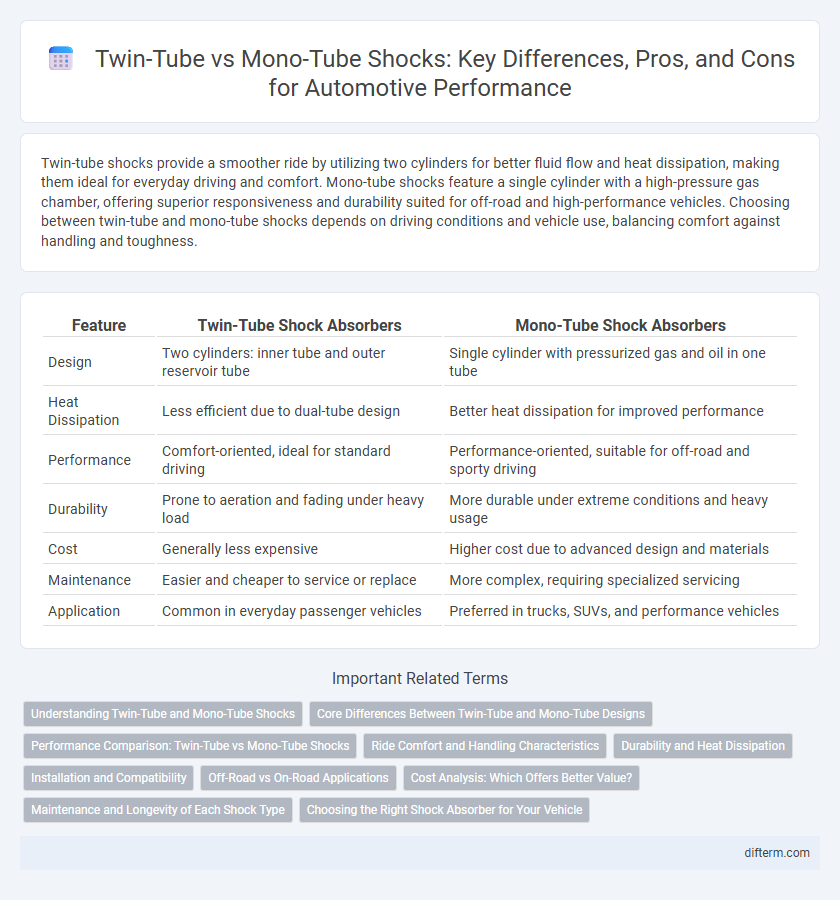Twin-tube shocks provide a smoother ride by utilizing two cylinders for better fluid flow and heat dissipation, making them ideal for everyday driving and comfort. Mono-tube shocks feature a single cylinder with a high-pressure gas chamber, offering superior responsiveness and durability suited for off-road and high-performance vehicles. Choosing between twin-tube and mono-tube shocks depends on driving conditions and vehicle use, balancing comfort against handling and toughness.
Table of Comparison
| Feature | Twin-Tube Shock Absorbers | Mono-Tube Shock Absorbers |
|---|---|---|
| Design | Two cylinders: inner tube and outer reservoir tube | Single cylinder with pressurized gas and oil in one tube |
| Heat Dissipation | Less efficient due to dual-tube design | Better heat dissipation for improved performance |
| Performance | Comfort-oriented, ideal for standard driving | Performance-oriented, suitable for off-road and sporty driving |
| Durability | Prone to aeration and fading under heavy load | More durable under extreme conditions and heavy usage |
| Cost | Generally less expensive | Higher cost due to advanced design and materials |
| Maintenance | Easier and cheaper to service or replace | More complex, requiring specialized servicing |
| Application | Common in everyday passenger vehicles | Preferred in trucks, SUVs, and performance vehicles |
Understanding Twin-Tube and Mono-Tube Shocks
Twin-tube shocks feature two nested cylinders with hydraulic fluid and gas separated to enhance ride comfort and absorb road vibrations effectively, making them ideal for everyday driving conditions. Mono-tube shocks contain a single tube with a high-pressure gas chamber that improves heat dissipation and provides superior handling and stability on rough terrain and high-performance applications. Understanding the structural differences clarifies that twin-tube designs prioritize smoothness, while mono-tube shocks deliver better control and durability under demanding driving scenarios.
Core Differences Between Twin-Tube and Mono-Tube Designs
Twin-tube shocks feature an inner and outer tube filled with hydraulic fluid, providing a dual-chamber system that offers a softer ride and better isolation from road imperfections. Mono-tube shocks utilize a single tube with a high-pressure gas chamber, delivering superior heat dissipation, quicker response, and enhanced durability under extreme conditions. The core differences center on construction, damping performance, and heat management, affecting vehicle handling and ride comfort.
Performance Comparison: Twin-Tube vs Mono-Tube Shocks
Mono-tube shocks deliver superior heat dissipation and consistent damping performance, making them ideal for high-performance and off-road vehicles. Twin-tube shocks offer a more comfortable ride with better absorption of small road imperfections, typically suited for daily driving conditions. The rigid construction of mono-tube shocks enhances stability and handling, while twin-tube designs provide extended lifespan under moderate stress.
Ride Comfort and Handling Characteristics
Twin-tube shocks provide enhanced ride comfort by offering smoother damping through an inner tube surrounded by a fluid reservoir, which absorbs road irregularities effectively. Mono-tube shocks excel in handling characteristics due to their single tube design allowing better heat dissipation and improved responsiveness during aggressive driving or off-road conditions. Choosing between twin-tube and mono-tube shocks impacts vehicle dynamics, with twin-tube favoring passenger comfort and mono-tube prioritizing precise control and stability.
Durability and Heat Dissipation
Mono-tube shocks offer superior durability due to their single-chamber design, which minimizes internal component wear and enhances resistance to harsh driving conditions. Their larger surface area improves heat dissipation, reducing the risk of shock fade during extended use. Twin-tube shocks have a dual-chamber design that provides smoother ride quality but is generally less effective at heat management and may experience quicker degradation under extreme stress.
Installation and Compatibility
Twin-tube shocks typically offer easier installation due to their standard design and are widely compatible with most passenger vehicles and light trucks. Mono-tube shocks require precise mounting locations because of their single, larger internal tube and often demand specific brackets or adapters, making them more suitable for performance or off-road vehicles. Compatibility depends largely on vehicle suspension geometry and intended use, where twin-tube shocks excel in comfort-oriented setups and mono-tube shocks in enhanced handling and durability applications.
Off-Road vs On-Road Applications
Twin-tube shocks, with their dual-chamber design, excel in on-road applications by providing smoother rides and better handling over regular pavement due to enhanced heat dissipation and stable damping. Mono-tube shocks, featuring a single-cylinder design, deliver superior performance in off-road conditions through improved durability, quicker heat dissipation, and consistent damping under extreme terrain stress. Off-road enthusiasts prefer mono-tube shocks for aggressive driving and rough terrain, while daily drivers seeking comfort and control on paved roads often opt for twin-tube configurations.
Cost Analysis: Which Offers Better Value?
Mono-tube shocks generally offer better long-term value despite a higher initial cost due to superior durability and enhanced heat dissipation, which reduces maintenance frequency. Twin-tube shocks are more cost-effective upfront and suitable for budget-conscious drivers but may require more frequent replacements under demanding driving conditions. Evaluating total ownership cost, including lifespan and performance, positions mono-tube shocks as the preferred choice for those seeking optimal investment in shock absorber technology.
Maintenance and Longevity of Each Shock Type
Twin-tube shocks generally offer easier maintenance due to their simpler design and cost-effective repair options, making them suitable for everyday driving conditions. Mono-tube shocks feature a more robust construction with a single tube and high-pressure gas, providing enhanced durability and longer lifespan under heavy-duty or off-road use. Regular inspection of seals and fluid levels extends the longevity of both types, though mono-tube shocks tend to withstand heat and wear better, reducing maintenance frequency.
Choosing the Right Shock Absorber for Your Vehicle
Choosing the right shock absorber for your vehicle depends on driving style, terrain, and suspension needs. Twin-tube shocks offer a softer, more comfortable ride suitable for everyday driving and light off-roading, while mono-tube shocks provide better heat dissipation, improved handling, and durability for aggressive driving and heavy-duty use. Evaluating factors such as vehicle weight, terrain, and performance expectations ensures optimal shock absorber selection for safety and ride quality.
Twin-Tube vs Mono-Tube Shocks Infographic

 difterm.com
difterm.com